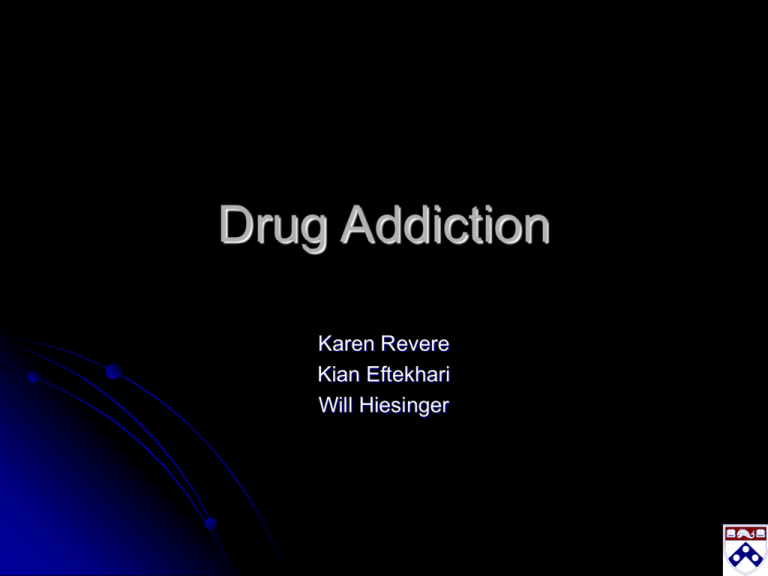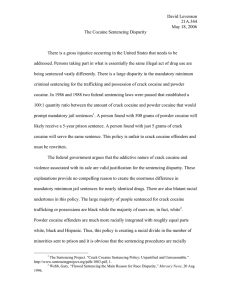Drug Addiction
advertisement

Drug Addiction Karen Revere Kian Eftekhari Will Hiesinger What happens when you smoke crack? Euphoria Wakefulness Anorexia Psychomotor activation Increased energy Increased confidence Sexual arousal Alertness/vigilance/anxiety Racing thoughts Tachycardia (fast heart rate) Grandiosity Hypertension (high blood pressure) Perspiration Mydriasis (pupil dilation) Courtesy of Charles A. Dackis, MD What is difference between CRACK-cocaine and powder cocaine? Crack Cocaine Powder Cocaine VS. Courtesy of Charles A. Dackis, MD Powder cocaine is not well-suited for smoking because the temperature at which it vaporizes is very high, and close to the temperature at which it burns. Crack cocaine is insoluble in water and is therefore not suitable for drinking, snorting or injecting. However, it vaporizes at a much lower temperature than powdered cocaine, which makes it suitable for inhalation Powder cocaine, when snorted, typically begins working in about 15 minutes and can last several hours. Crack cocaine is absorbed immediately into blood via the lungs, where it reaches the brain in about five seconds. The rush is much more intense than snorting powder cocaine, but the peak of the rush is over almost as soon the vapor is exhaled and the high typically lasts only 5–10 minutes. Powder cocaine is EXPENSIVE! Crack cocaine is CHEAP! How does Crack get to the brain? What does the Crack do when it gets to the brain? But first we need some help… What do these words mean? DENDRITE…AXON…SYNAPSE…NEUROTRANSMITTER DENDRITE Dendrites are the branched projections of a neuron that act to conduct the electrical stimulation received from other neural cells to the cell body, or soma, of the neuron from which the dendrites project. AXON An axon is a long, slender projection of a nerve cell, or neuron, that conducts electrical impulses away from the neuron's cell body or soma. SYNAPSE Synapses are specialized junctions through which cells of the nervous system signal to one another and to nonneuronal cells such as muscles or glands. NEUROTRANSMITTER Neurotransmitters are chemicals that are used to relay, amplify and modulate electrical signals between a neuron and another cell. So what exactly does Crack do to the brain? Dopamine transmitter released during neural signaling is normally recycled via the transporter (DAT); i.e., the transporter binds the transmitter and pumps it out of the synaptic cleft back into the presynaptic neuron, where it is taken up into storage vesicles. Cocaine binds tightly at the DAT forming a complex that blocks the transporter's function. The DAT can no longer perform its reuptake function, and thus dopamine accumulates in the synaptic cleft. This results in an enhanced and prolonged post-synaptic effect of dopaminergic signalling at dopamine receptors on the receiving neuron.








